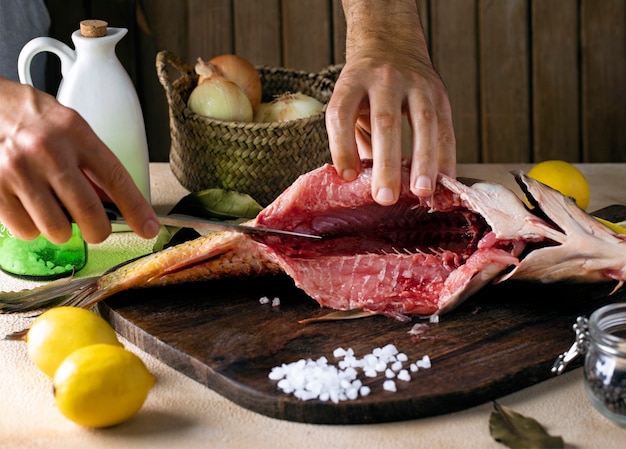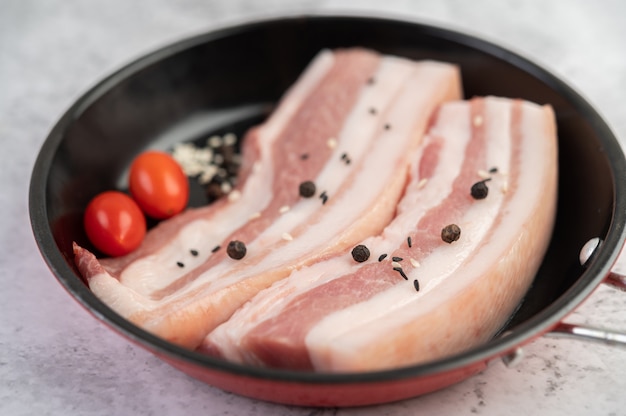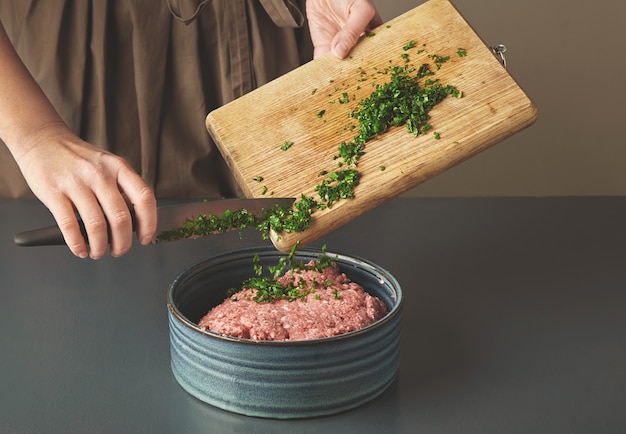The aroma of a roasting ham is enough to transport me back to childhood holidays, bustling family gatherings, and the comforting warmth of a shared meal. There’s just something about that salty, smoky, and slightly sweet scent that evokes pure joy. But I’ll admit, tackling a bone-in ham can feel a bit intimidating, especially for novice cooks. choosing the right cut, figuring out the cooking method, and then the whole glaze situation - it can all seem overwhelming.
But fear not, my fellow food enthusiasts! I'm here to walk you through the process, sharing all the tricks and tips I've picked up over the years. You’ll be surprised at how straightforward it is, and the end result? A delicious, perfectly cooked ham that’ll impress even the pickiest eaters in your family.
(Part 1) Choosing the Right Ham: It’s All About the Cut

The first step on your ham-cooking journey is selecting the perfect piece. And by perfect, I mean the right cut, the ideal size, and the type that best suits your taste and culinary goals.
A Matter of Whole or Half
You’ll first encounter a fork in the road: whole hams versus half hams.
A whole ham, as you might guess, is the entire leg of a pig. Think substantial! These beauties usually weigh in between 12 and 20 pounds, making them ideal for large gatherings or a serious commitment to leftover sandwiches. They do, however, require a bit more patience as they take quite a bit of time to cook.
A half ham, on the other hand, is simply a whole ham cut in half, making it a more manageable size (typically between 6-10 pounds). While still big enough to feed a crowd, they cook significantly faster than their whole counterparts.
Sizing Up Your Needs
Once you’ve settled on whole or half, it’s time to consider the size. How many hungry mouths are you feeding? How much leftover ham are you willing to contend with (or rather, looking forward to)?
If you’re catering to a party of 10 or more, a whole ham is your best bet. For a more intimate gathering of 5-10 people, a half ham should be sufficient. And if you’re just cooking for yourself and a couple of others, a smaller half ham (around 4-6 pounds) will be the perfect portion.
The Great Ham Typology
Now, let’s dive into the fascinating world of ham types. There are three main categories: city ham, country ham, and spiral ham.
City ham is cured with salt and other seasonings and often smoked, resulting in a milder flavor and a delicate texture.
Country ham is cured with salt, sometimes with a touch of sugar, but it’s not smoked. This process gives it a more robust, saltier flavor and a chewier texture.
Spiral ham, often a city ham, has been sliced and boned, then rolled into a spiral, making it incredibly easy to carve and cook.
For my fellow ham-cooking newbies, I always recommend starting with a city ham or a spiral ham. They’re both incredibly user-friendly and have a more forgiving flavor profile.
(Part 2) Prepping the Ham: Getting Ready to Cook

Now that you’ve found your perfect ham, it’s time to prepare it for cooking. This might seem like a simple step, but a few key actions ensure your ham comes out juicy, flavorful, and absolutely irresistible.
Unveiling Your Ham
First things first, remove the ham from its packaging. It’ll likely be wrapped in plastic and possibly even a netting to keep it in shape.
A Refreshing Rinse
Give your ham a thorough rinse under cold running water. This step removes any excess salt or seasonings that might have been used during the curing process.
Patting it Dry
After the rinse, gently pat the ham dry using paper towels. This helps the ham brown beautifully in the oven and promotes a crispier skin.
The Art of Scoring
Here’s where we get a little fancy! Scoring the ham, which means making shallow cuts into the fat layer, is a trick I learned from seasoned cooks. These cuts not only help the ham cook more evenly but also allow the glaze to penetrate more deeply, creating a truly decadent flavor.
Use a sharp knife to create cuts that are about 1/2 inch deep and 1 inch apart, covering the entire surface of the ham. Remember, you’re only cutting into the fat layer, not the meat itself.
(Part 3) Choosing Your Cooking Method: A World of Options

Now we get to the fun part: deciding how to cook your masterpiece! You’ve got several options at your disposal, each with its own unique advantages and potential challenges.
The Tried-and-True Oven-Baking Method
Oven-baking is the classic way to cook a ham, and for good reason. It’s simple, reliable, and produces a beautiful, crispy skin that’s practically begging to be devoured.
slow cooker: Hands-Off Cooking for Busy Cooks
If you’re looking for a hands-off approach that lets you focus on other things while the ham simmers, the slow cooker is your best friend. While it takes longer than oven-baking, it consistently delivers a super-tender, flavorful ham. Feel free to add vegetables or fruits to the slow cooker for a complete, wholesome meal.
Grilling: Embrace the Smoky Flavor
For a bolder smoky flavor, grilling is a fantastic option. Make sure your grill is hot and that you’re using a high-quality ham, as the intense heat can dry out a lower-quality ham.
Smoking: For the Serious Foodie
Smoking a ham is a commitment. It requires patience, a smoker, and a serious dedication to achieving that deep, smoky flavor that truly elevates a ham to the next level. It’s definitely worth the effort if you’re looking for an impressive centerpiece for your table.
(Part 4) Oven-Baking the Ham: A Detailed Guide
In this guide, I’m going to focus on oven-baking, my go-to method because it’s simple, versatile, and consistently produces delicious results.
1. Preheat Your Oven: The Foundation of a Good Bake
Preheat your oven to 325°F (165°C). This ensures the ham cooks evenly and achieves that beautiful golden-brown color.
2. The roasting pan: A Ham’s Home
Place your ham in a large roasting pan. If your ham is particularly large, you might need two pans to accommodate it comfortably.
3. A Touch of Moisture: Keeping it Juicy
Pour about 1 cup of water or apple juice into the bottom of the roasting pan. This creates a steamy environment that helps keep the ham moist during cooking, preventing it from drying out.
4. Foil: The Ham’s Protective Shield
Cover the ham tightly with aluminum foil. This ensures even cooking and prevents the ham from losing moisture, leading to a more tender and juicy result.
5. Time to Calculate: cooking time
Here’s where we get a bit mathematical. Calculate the cooking time based on the ham’s weight, as it’s a key factor in achieving perfect doneness.
For a whole ham, aim for approximately 18-20 minutes of cooking time per pound. For a half ham, aim for about 20-25 minutes per pound.
For example, if you have a 10-pound half ham, you’ll need to cook it for 3-4 hours.
6. Time to Cook: Let the Oven Work its Magic
Place the roasting pan with your covered ham in the preheated oven and let it cook for the calculated time. Resist the urge to peek too often, as opening the oven door can disrupt the cooking process.
(Part 5) Checking for Doneness: Mastering the internal temperature
Overcooking a ham is a culinary crime! It leads to a dry, tough ham that’s far from the tender delight we’re aiming for. So, before you remove your ham from the oven, check for doneness to ensure perfect results.
1. meat thermometer: The Foolproof Method
The most reliable way to determine doneness is by using a meat thermometer. Insert the thermometer into the thickest part of the ham, avoiding the bone. Aim for an internal temperature of 145°F (63°C). Once the thermometer reaches that temperature, your ham is ready to be taken out of the oven.
2. No Thermometer? Don’t Panic!
If you’re not equipped with a meat thermometer, there are a few other ways to check for doneness. Gently press on the ham. It should feel firm to the touch, and the juices that run from the ham should be clear.
(Part 6) Glazing the Ham: Adding that Extra Touch of Flavor
Once your ham is perfectly cooked, it’s time to give it that gorgeous golden-brown color and a burst of irresistible flavor: We’re talking about glazing!
Choosing the Perfect Glaze: A World of Flavor
The possibilities for glazes are endless, ranging from sweet and savory to spicy and tangy. I recommend choosing a glaze that complements the flavor of your ham.
For a classic glaze, try a simple honey mustard glaze. For a more sophisticated option, try a bourbon maple glaze. And for a sweet and tangy glaze, try a pineapple glaze.
Applying the Glaze: A Glaze of Glory
Once the ham is out of the oven, remove the aluminum foil and generously pour your chosen glaze over the ham.
You can use a basting brush or simply spoon the glaze over the ham. Just ensure it’s evenly distributed, coating the entire surface.
Finishing Touches: Bringing it Home
Now you have a choice: You can return the glazed ham to the oven to allow the glaze to set and caramelize, or you can broil it for a few minutes for a crispy finish.
Just be mindful not to overcook the ham at this stage, as it will dry out.
(Part 7) Resting and Slicing: The Final Steps to Culinary Success
After all the effort, your ham deserves a well-deserved rest. This allows the juices to redistribute throughout the meat, making for a juicier, more flavorful ham.
Resting: A Time for Relaxation
Let the ham rest for 15-20 minutes before slicing. This might seem like a small detail, but it makes a big difference in the overall flavor and texture.
Slicing: Presenting Your Masterpiece
Now for the fun part: Slicing! You can use a carving knife or a regular kitchen knife to slice the ham into thin, even slices.
If you’re serving the ham whole, you can carve it at the table. But if you’re serving it sliced, I recommend carving it ahead of time and arranging it beautifully on a platter.
(Part 8) Serving and Storing Leftovers: Savoring Your Ham
Congratulations! You’ve cooked a perfect ham. Now it’s time to enjoy the fruits of your labor.
Serving: A Feast for the Senses
Serve the ham hot or cold, depending on your preference and the occasion. I personally love serving it hot with a side of creamy mashed potatoes, tender green beans, and a tangy cranberry sauce.
Storing Leftovers: The Magic of ham sandwiches
Any leftover ham can be stored in an airtight container in the refrigerator for up to 5 days. You can also freeze leftover ham for up to 3 months.
The possibilities for leftover ham are endless. Think ham and cheese sandwiches, hearty ham and bean soup, a comforting ham and potato hash, or even a delightful ham and egg breakfast.
FAQs: Answers to Your Ham-Cooking Questions
1. Can I Cook a Ham from Frozen?
Yes, you can cook a ham from frozen. However, you’ll need to add an extra 30 minutes of cooking time per pound to ensure it’s cooked through.
2. What if My Ham is Overcooked?
If you happen to overcook your ham, it will become dry and tough. Don’t fret! You can still salvage it by slicing it thinly and using it in a soup, stew, or casserole.
3. Can I Add Vegetables to the Roasting Pan?
Absolutely! You can add vegetables to the roasting pan with the ham. Just make sure the vegetables are cut into bite-sized pieces and don’t overcrowd the pan.
4. What’s the Best Way to Carve a Ham?
Start by carving the ham into thick slices. Then, you can cut those slices into smaller pieces for easier serving.
5. What Are Some Good Leftover ham recipes?
The options for leftover ham are truly endless! You can make classic ham and cheese sandwiches, a comforting ham and bean soup, a flavorful ham and potato hash, a hearty ham and egg breakfast, or even a delightful ham salad.
Remember, cooking a ham is a journey of flavor and family. Have fun with the process, experiment with different glazes, and enjoy the delicious results!
Everyone is watching

How to Cook Frozen Lobster Tails Perfectly: A Step-by-Step Guide
RecipesLobster. Just the word conjures up images of lavish meals, special occasions, and a taste of luxury. But let's...

Pigs in a Blanket Cooking Time: How Long to Bake for Perfect Results
RecipesAh, pigs in a blanket. Just the name conjures up images of those delightful little parcels of crispy pastry en...

Pork Fillet Cooking Time: How Long to Cook It Perfectly
RecipesPork fillet, or tenderloin as it's sometimes called, is a real favourite in our house. It's so versatile, and...

The Ultimate Guide to Cooking Delicious Frankfurters
RecipesLet's face it, we all love a good frankfurter. It's a classic, simple, and always satisfying. But let's be rea...

Wolf Meat Recipes: A Guide to Cooking Wild Game
RecipesLet's be honest, you don't see wolf meat at your local butcher shop every day. It's a bit of a wild card, but ...
